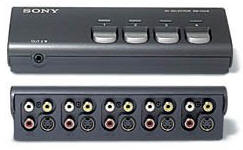George Graves, October 27, 2005
HDTV Solutions
One of the bigger problems encountered with today's HDTV and HDTV "Ready" sets, or for that matter, any kind of TV, is that few of them have enough inputs. You might have a DVD player, a tape player, a computer, a game console, an over the air antenna receiver, a set-top box from your cable provider, or a receiver from your satellite service and you would like to connect each of them to your HDTV. that's six possible devices that need a connection to your HDTV. An A/V receiver could no doubt address this problem, but you might save yourself hundreds or thousands of dollars with a simple switch box.
The Need
If your video devices have composite video, S-Video (also known as "YC"), or component video as their primary output, then a simple switch box can let you share one TV video connection with four different video devices. Of these video types, if you have a choice of video outputs, component video is the best of the three with S-Video being the next best for quality.
Many TVs have a composite input, an S-Video input, a set of component inputs and perhaps a VGA (sometimes switchable between component and VGA) or DVI input. However, the problem seems be that there are never enough component inputs. A new HDTV might have two or three component inputs at best. Obviously, a switchbox is required. Such switchboxes or "input multiplier" boxes are available, but most are expensive. Yet there is a cheap and simple solution; one that has been overlooked by just about everybody.
The Solution
So where do you find a video switch? If you go to your local video or electronics store, you will usually find them in the video cable department. Look for a blister pack with a small box that has four simple mechanical switches that allow switching of either four composite video or S-video sources into one single input along with each input's stereo sound
 |
| Sony SB-V40S |
Where's the Component Video?
"Fine." I hear you saying to yourself. "But what has all this to do with HDTV if it doesn't support component video?" Good question. The secret has to do with the printed circuit board. Because this board is a single-layer board, all the switch and jack pathways are not only parallel, but also they're exactly alike. There is no difference between the audio paths on the board and the composite video path. This means that the jacks provided for audio are no different than the jacks provided for video. Has the light bulb in your head come on yet?
The Implementation
Ok, let me explain. A component video cable consists of three cables with RCA-type plugs. The cables are typically color coded blue, red and green to identify the signals Pb-Pr-Y (sometimes written as Cb-Cr-Y if the signal is digital). With these boxes it is possible to use the composite video and the left and right audio jacks for these three video signals.
For example, if you have component video on your XBOX and your DVD player and one component input into your HDTV, then using three sets of component video cables, connect each product to the video switch and the output of the video switch to the component video input of your HDTV. Now with the push of a button you can quickly connect the XBOX or the DVD player to your HDTV.
The switches are all mechanical, so there are no bandwidth issues, and the jacks and paths for the video and audio are identical. When cabling it up, just make sure the cable paths originate and end in the appropriate Pb-Pr-Y connectors. It works flawlessly and I've been using a Recoton in my system for six years without the switches becoming noisy and without any cross-signal interference! Best of all, these boxes are cheap (less than $40) and almost universally available. Give one a try, you won't be disappointed.